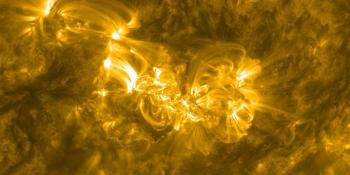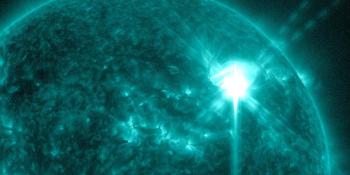Viendo archivo del sábado, 5 octubre 2002
Informe actividad solar
Any mentioned solar flare in this report has a scaling factor applied by the Space Weather Prediction Center (SWPC). Because of the SWPC scaling factor, solar flares are reported as 42% smaller than for the science quality data. The scaling factor has been removed from our archived solar flare data to reflect the true physical units.
Informe de actividad Solar-Geofísica 2002 Oct 05 2200 UTCPreparado por NOAA © SWPC y procesado por SpaceWeatherLive.com
Informe conjunto USAF/NOAA de actividad Solar y Geofísica
SDF Número 278 Publicado el 2200Z a las 05 Oct 2002IA. Análisis de regiones solares activas y de actividad desde 04-2100Z hasta 05-2100Z Solar activity reached high levels again this period.
Region 139 (N12E32) produced a major flare late in the period, an
M5/1n flare (in progress at issue time), and a Type II radio sweep
(404 km/s). The flare began at 05/2042Z and appears to have peaked
at M5.9 at 2100Z. This region also produced an M2/Sf at 04/2243Z
with associated Type II sweep (418 km/s). The rapid growth observed
yesterday has slowed considerably, and though no delta configuration
is obvious today, the region continues to grow slowly and now nears
700 millionths of white light areal coverage. Region 137 (S19W33)
produced an M1/Sf at 05/1046Z. This region has settled down after
producing four M-class flares in the last period. Some slight decay
was noted. New Regions 141 (S07E20) and 142 (N07E64) were numbered
today.
IB. Pronóstico de la actividad solar
Solar activity is expected to continue
at moderate to high levels. M-class activity is likely from Regions
137 and 139, and there's a small chance for another major flare from
Region 139.
IIA. Resumen de la actividad geofísica 04-2100Z a 05-2100Z
The geomagnetic field was at unsettled to minor storm levels. The Bz
component of the interplanetary magnetic field continues to be
predominantly southward. The greater than 2 MeV electron flux
reached moderate to high levels.
IIB. Pronóstico de la actividad geofísica
The geomagnetic field is
expected to continue at unsettled to minor storm levels. Transient
effects from the rather weak CMEs on 3 and 4 Oct may enhance the
disturbed periods on days one and two. A large, recurrent southern
coronal hole will move into geoeffective position late on day two
through day three.
III. Probabilidades del evento 06 Oct a 08 Oct
| Clase M | 60% | 50% | 50% |
| Clase X | 10% | 10% | 10% |
| Protón | 05% | 05% | 05% |
| PCAF | yellow | ||
IV. Penticton 10.7cm flujo
Observado 05 Oct 155 Previsto 06 Oct-08 Oct 160/170/175 Media de 90 Días 05 Oct 179
V. Índices Geomagnéticos A
Observado Afr/Ap 04 Oct 043/048 Estimado Afr/Ap 05 Oct 022/025 Previsto Afr/Ap 06 Oct-08 Oct 020/020-020/020-025/025
VI. Probabilidades de Actividad Geomagnética 06 Oct a 08 Oct
| A. Latitudes Medias | |||
|---|---|---|---|
| Activo | 50% | 50% | 50% |
| Tormenta Menor | 25% | 25% | 25% |
| Tormenta Mayor-Severa | 10% | 10% | 10% |
| B. Latitudes Altas | |||
|---|---|---|---|
| Activo | 50% | 50% | 50% |
| Tormenta Menor | 35% | 35% | 35% |
| Tormenta Mayor-Severa | 15% | 10% | 10% |
< < Ir a la visión general diaria
Últimas noticias
Últimos mensajes del foro
AR3664 233[CME] AR 13664, X1.04, 2024-05-08 46Filaments and prominences 87Incoming Active Regions 242Unproven theories 385
Más temasApoye a SpaceWeatherLive.com!
Mucha gente viene a SpaceWeatherLive para seguir la actividad del Sol o previsión de aurora, pero con esta cantidad de tráfico se incrementan los costos del servidor. ¡Considere hacer una donación si disfruta de SpaceWeatherLive para que podamos mantener el sitio web en línea!

Hechos clima espacial
| Último evento clase X | 2024/05/08 | X1.0 |
| Último evento clase M | 2024/05/08 | M2.0 |
| Últimas tormentas geomagnéticas | 2024/05/06 | Kp5 (G1) |
| Días sin manchas | |
|---|---|
| Último día sin manchas | 2022/06/08 |
| Promedio de manchas solares mensuales | |
|---|---|
| abril 2024 | 136.5 +31.6 |
| Last 30 days | 161.2 +69.2 |


